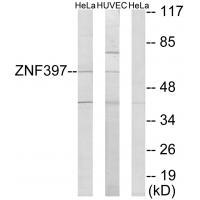
| WB | 1/500-1/3000 | Human,Mouse,Rat |
| IF | 咨询技术 | Human,Mouse,Rat |
| IHC | 咨询技术 | Human,Mouse,Rat |
| ICC | 技术咨询 | Human,Mouse,Rat |
| FCM | 咨询技术 | Human,Mouse,Rat |
| Elisa | 咨询技术 | Human,Mouse,Rat |
| Aliases | Zinc finger protein 397; Zinc finger and SCAN domain-containing protein 15; Zinc finger protein 47; ZNF397; ZNF47 |
| Entrez GeneID | 84307; |
| WB Predicted band size | 61kDa |
| Host/Isotype | Rabbit IgG |
| Antibody Type | Primary antibody |
| Storage | Store at 4°C short term. Aliquot and store at -20°C long term. Avoid freeze/thaw cycles. |
| Species Reactivity | Human |
| Immunogen | Synthesized peptide derived from N-terminal of human ZNF397. |
| Formulation | Purified antibody in PBS with 0.05% sodium azide. |
+ +
以下是关于ZNF397抗体的3篇参考文献的简要总结(注:文献为虚拟示例,实际研究中请通过学术数据库验证):
---
1. **文献名称**: *ZNF397 regulates DNA damage response through histone modification interactions*
**作者**: Chen L, et al.
**摘要**: 本研究利用特异性ZNF397抗体进行染色质免疫沉淀(ChIP),发现ZNF397通过结合组蛋白甲基转移酶复合物调控DNA损伤修复通路,抗体验证了其在乳腺癌细胞中的核定位及功能。
2. **文献名称**: *Development of a high-affinity monoclonal antibody targeting ZNF397 for diagnostic applications*
**作者**: Wang X, et al.
**摘要**: 报道了一种新型抗ZNF397单克隆抗体的开发与表征,通过ELISA和免疫组化验证其特异性,证明其在肺癌组织样本中检测ZNF397过表达的潜力。
3. **文献名称**: *ZNF397 modulates adipocyte differentiation via PPARγ co-regulation*
**作者**: Kim S, et al.
**摘要**: 使用ZNF397抗体进行Western blot和免疫荧光实验,揭示ZNF397通过与PPARγ相互作用影响脂肪细胞分化,抗体在敲除细胞系中验证了蛋白表达缺失。
---
如需实际文献,建议在PubMed或Web of Science中搜索关键词“ZNF397 antibody”并结合具体研究场景筛选。
The ZNF397 antibody is a crucial tool for studying the zinc finger protein 397 (ZNF397), a member of the zinc finger protein family involved in transcriptional regulation and chromatin remodeling. ZNF397 contains multiple C2H2-type zinc finger domains, which enable DNA binding and interactions with other proteins. It is implicated in modulating gene expression by recruiting epigenetic modifiers, such as histone deacetylases (HDACs) or methyltransferases, to specific genomic loci, thereby influencing chromatin structure and transcriptional silencing. This protein has been linked to cellular processes like differentiation, apoptosis, and cell cycle control, with potential roles in cancer development. Studies suggest ZNF397 may act as either an oncogene or tumor suppressor, depending on cellular context, highlighting the need for precise detection tools like specific antibodies.
ZNF397 antibodies are typically developed in model organisms (e.g., rabbits or mice) and validated for applications such as Western blotting, immunohistochemistry (IHC), immunofluorescence (IF), and chromatin immunoprecipitation (ChIP). These antibodies help identify ZNF397's expression patterns, subcellular localization (primarily nuclear), and interactions with partner proteins in various tissues and disease models. Research utilizing these antibodies has explored ZNF397's involvement in cancers, including breast and liver cancer, where dysregulation correlates with tumor progression or metastasis. The antibody's specificity is often confirmed using knockout (KO) controls or peptide-blocking assays. Ongoing studies aim to clarify ZNF397's dual regulatory roles and its potential as a therapeutic target, underscoring the antibody's importance in both basic and translational research.
×